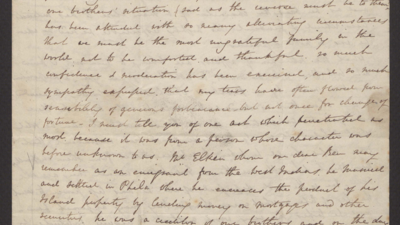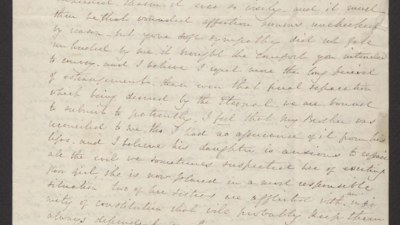Oral History Interview with Harold Stern
Title
Date
Contributor
Summary
Harold Stern, formerly Helmutt, was born August 31, 1921 in Frankfurt am Main, Germany, the only child of middle class Jewish parents. His father came from an Orthodox background and his mother was raised in a non-observant home; as a family, they belonged to a large Liberal Congregation, the West end Synagogue in Frankfurt. Harold describes the educational system and antisemitism pre- and post- 1933. He discusses the Kultusgemeinde, his Jewish education, upbringing, and his studies at the Philanthropin (a Jewish secondary school), which he attended in 1935 due to increased Nazism and antisemitism experience at the public Gymnasium. His mother continued the family business after his father’s death in 1930, but had to give it up (1937) as a result of the Nuremberg Laws. He describes the “aryanization” of a shoe manufacturing company and other businesses where he was apprenticed/employed. Despite having an early quota number, Harold’s attempts to emigrate with his mother to USA were thwarted because their affidavits were not accepted by the American Consulate in Stuttgart. In March 1939, Harold left for England through the aid of family friends in England and Bloomsbury House, while his mother remained in Frankfurt. He describes life in London, working as a factory trainee, residing among British (non-Jewish) working class, until June 1940 when he was picked up and interned in Huyten, a camp near Liverpool, with other German Jewish refugees. In July 1940, he volunteered for transport on the Dunera, a ship supposedly bound for Canada but re-routed to Australia. He discusses in detail the desperate conditions at sea, harsh treatment by British soldiers, and refugee behavior during the ten week voyage. From Sidney, he was transferred to a barbed-wire enclosed compound in the Outback, in Hay, New South Wales. He refers to the internal camp leadership which emerged, the development of cultural and educational activities. He details help given by the Australian Christian Student Movement (under Margaret Holmes), Jewish Welfare Board, and Jewish people of Melbourne. Later he moved to a camp in Tatura, Victoria that had better conditions. After 20 months of internment, he joined the Australian army, the 8th Employment Company, where he did transport of munitions. He was discharged in 1946 or 1947, after serving 4 1/2 years in the army.
Harold kept contact with his mother and knew that she reached USA in late 1941. Through the help of a non-Jewish woman, she obtained a visa in September 1941, left Germany on a sealed train (to Berlin), journeyed through occupied and Vichy France and Spain to Lisbon, boarding one of the last steamers from Portugal to America. Her brother, however, was arrested by the Gestapo and never seen again. Her sister, a musician, later hospitalized in a sanitarium was “euthanized”.
Harold immigrated to the USA in 1947 under the German quota. In 1959, he moved to Philadelphia.
none
More Sources Like This
of
Nelly B. Thalheimer
Nelly B. Thalheimer, nee Bokros1, was born October 4, 1929 into a middle-class Jewish family in Belgrade, Yugoslavia. She shares her childhood memories of pre-war life. She attended public school until 1941, when the government formed an alliance with Hitler and Mussolini. Days before the German invasion her father insisted they flee. They were seized by the German Army in Split and interned on the island of Korcula. She describes the conditions there: confined to house arrest, they were dependent on black market trading and fisherman who shared seafood freely. She and her two siblings supplemented the family diet with stolen potatoes.
Nelly details her family’s separation in 1943, when Italy capitulated, and how she, her sister and mother spent two weeks with partisans in the woods to avoid Germans soldiers. She describes her family’s reunion and escape by sailboat to a POW camp in Bari, Italy run by the Americans and the British. They remained there until August 1944, when they were granted a temporary stay in Oswego, New York by President Roosevelt’s executive order. HIAS, ORT and the Friends Service Committee facilitated their permanent residence. Nelly married Hans Thalheimer in 1955.
She is troubled by young Jews in the United States including her three children, who assimilate, and she feels that more Holocaust memorials and educational programs are needed.
Maiden name possibly spelled Bokris.
of
Isadore Hollander
Isadore Hollander, born 1920 in Paris, returned to Bendin (Będzin), Poland with his Polish parents and older sister in 1923. He describes in detail the pre-war Jewish community. Following his father’s death and mother’s re-marriage, he lived, from ages 11 to 15, in an orphanage operated according to Janusz Korczak guidelines, which he describes in detail. During this period, he joined a Zionist youth group. He mentions growing antisemitism in Poland.
After September 1939, he ran from town to town, to avoid forced labor, until captured and sent to work in a coal mine in Jaworzno near Krakow. He escaped to Russian-occupied Poland, living in Lvov at the beginning of 1940. To avoid imprisonment for “illegal” business, he registered for work in Russian. Assigned to Stalino coal mine in the Donbas region, he escaped to Rovno and describes religious life there, winter, 1940-June 1941. After the Rovno Ghetto was established, he escaped from slave labor with help from former Polish soldiers. He lived with 10 other Jews in nearby forests until 1943, having minimal contact with Polish partisans, due to mutual suspicion. He later served in the Polish Army. His eye-witness account of German-evacuated Majdanek and detailed description of his life as a Polish soldier includes revenge he and other Jewish soldiers took on Volkdeutsche Poles. At the end of the war, he returned to Bendin and met his future wife. He details their escape from Poland and life in Deggendorf DP camp in Bavaria. They emigrated to Philadelphia in 1947.
See also the interview with his wife, Anni Hollander.
of
Herman Krauser
Herman Krauser served as an 89th Infantry sergeant in Germany with the 3rd Army during World War II. He briefly mentions that he encountered prisoners liberated from Ohrdruf on April 3, 1945, when his company bypassed the camp while enroute to engage the enemy.
Most of this interview is a report - read by Mr. Krauser - based on testimonies of American soldiers in the 355th Regiment and the 4th Armoured Division who liberated Ohrdruf, describing brutal conditions.
of
Liza Kessler
Liza Kessler, nee Rak, was born in the Ukrainian town of Vinnitsa, located on the Polish border between Kiev and Odessa. A center of Jewish learning, it boasted 15 Jewish schools. Liza graduated from a Jewish high school, married and had two children. Liza describes how in July, 1941, after a German bombing raid, Polish Jews fled into her town. She heard reports from them that the Jews were herded into the synagogue and burned. Liza with her two children, and sisters-in-law and their children fled with the ‘echelons’ (transports which carried machinery). They boarded a barge for Central Asia. In November, 1941 they arrived in Georgia. They stayed on a kolkhoz (collective farm) until the Germans came. They then fled further East to Uzbekistan, finally landing in Bukhara where they stayed until the end of the war. Liza describes harsh conditions: food rationing and bitter cold. Liza’s sisters and parents were murdered in mass killings.
After World War II Liza went back to Poland with her second husband, a Jewish Polish national. Because it was too much like Russia, they left and were smuggled into the American zone in Austria via Czechoslovakia. Liza and her family stayed in Austria for five years. They were aided by the UNRRA (United Nations Relief and Rehabilitation Administration). Finally, in 1950, through an aunt in Philadelphia they received papers and were able to enter the United States as part of the quota.
Interviewee: KESSLER, Liza Date: January 18, 1983

